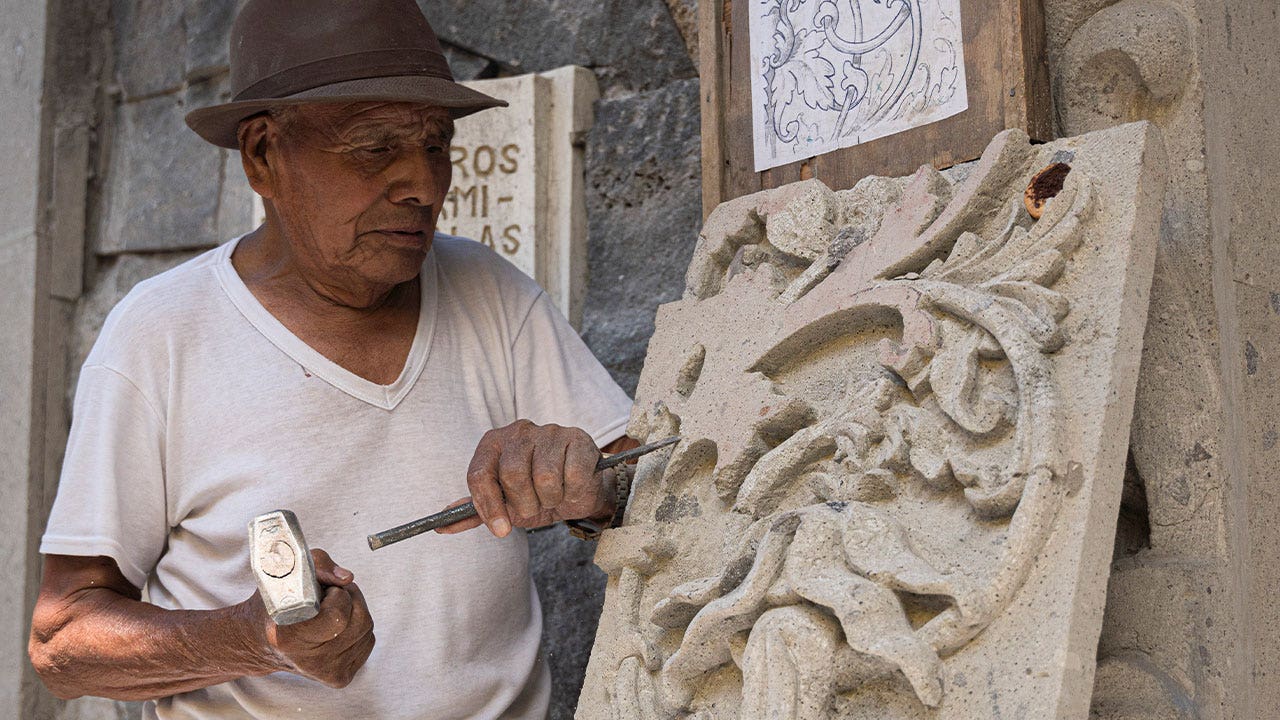The sound of hammers and chisels striking stone rings out on most Sundays in the cemetery of ancient Xochiaca, a village swallowed up decades ago by the urban sprawl of Mexico City.
It’s the sound of the stone carvers of Chimalhuacan — as the borough is known — who still pursue a craft passed down for generations, even after the local source of quarry stone was exhausted.
The village cemetery is filled with yard-high statues of saints and a knot of men who coax flower garlands and flowers out of the blocks of stone with their chisels.
Generations of stone carvers in Chimalhuacan, on Mexico’s City’s far east side, also created much of the stonework that adorns buildings and parks in the capital’s downtown.
While carvers in other areas long ago turned to mechanical cutters and polishers, the craftsmen here use only hammers, mallets and a variety of chisels and gouges.
Many are self-taught, but some, like Tomás Ugarte, 86, learned in the traditional way as handed down by fathers and grandfathers, dating back about five generations.
The group skews to an older demographic these days. There were about 600 registered stone carvers a decade ago, but Carolina Montesinos Mendoza, director of the Mexico State office that supports artisans, said there are probably only around 300 now. The carvers are dying off and their children generally don’t want to take up the trade,

Master stone carver Tomás Ugarte sculpts quarry at the cemetery in the Mexico City borough of Chilmalhuacan, once the ancient village of Xochiaca, on July 2, 2023. (AP Photo/Aurea Del Rosario)
With Xochiaca now lost in a labyrinth of city streets, they keep the old traditions alive. Many residents use stone mortars and pestles made by the stone carvers. Known as “molcajetes” in Spanish, these bowl-like grinders are the basic tool for making salsas.
“They are the backbone of the community,” said Rev. Alberto Sandoval, who has known them since 1990, when he served as a parish priest in Xochiaca.
Most of the carvers have individual workshops at home, which provide them with some income. They sell carvings for prices ranging from $500 to $2,000, but they often don’t sell much.
Unlike many craftspeople who want to see their works displayed in museums, the carvers here work free of charge to create and maintain carvings to decorate the local cemetery. Among those are an imposing, 20-foot stone Christ figure as well as European-inspired sculptures of the 12 apostles.
CELTIC GOLD COINS STOLEN FROM GERMAN MUSEUM IN STUNNING HEIST
They also work for free at decorating and maintaining the stonework at the 250-year-old parish church, Santa María de Guadalupe. They have made altar screens, columns and the Christ and Virgin Mary statues that are 10 feet tall.
One of the earliest signs of their predecessors’ work is a carved stone in the floor of the churchyard reading “Xochiaca, home of the stone carvers.” It does not bear a date.
It refers, however, to a time when the lake that once covered much of the valley still lapped at the shores of Xochiaca. Builders would come looking for carvings, and ship them to Mexico City on barges over the lake.
Juan Alfaro Bastidas, 75, is a carver, just as his father and grandfather were. He recalls going into the quarries by candlelight to get blocks of stone.
But the quarries are just a memory now.
CLICK HERE TO GET THE FOX NEWS APP
Largely played out, the land where they stood was sold for housing lots. Some of the newcomers considered it quaint, and used the sides of the quarry as walls in their homes.
Now, the carvers truck in stone from other states to the north and to the west, but sometimes from as far away as the southern state of Yucatan.
They get some help from donations from the local government and local residents.
“The neighbors have helped us out with donations of $6 to $12. The people of the town buy the stone,” said Bastidas.
Asked if the trade will survive, carver Mario Olivares recited a poem etched by the artisans in the church wall: “Your art, your tradition, your culture and the nobility of the people keep the soul of this town alive.”
